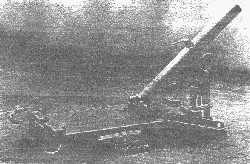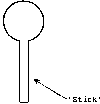|
| ||
| The 2-inch Howitzer | ||
| from "The Mortar" by WL Ruffell | ||
|
The terms 'howitzer' and 'mortar' tended to be interchangeable at the time, e.g. the Stokes 3-inch mortar was at first called a 'howitzer.' See Fig. 11. The 2-inch was manned by personnel seconded from 18-pr batteries, and used mainly for cutting barbed-wire, entanglements which quite often withstood action by field guns. It consisted of a steel tube of 2-inch internal diameter mounted upon a wooden base and supported by a bipod fitted with elevating and traversing gears. Elevation was applied by means of a clinometer, while for line a 'tall periscopic sight attached to the piece' was supplied. No details of this sight are available. Propellant charges consisted of packets of cordite of one and 1½ oz (28 and 44 grams), used to make up charges of 1½, 2½, and 3½ ounces, giving ranges of 100-220. 180-340, and 300-500 yards respectively. NB: To convert yards to metres multiply by 36 and divide by 39.37. Owing to the nature of the bomb, the charges were loaded separately by dropping them down the barrel. Ignition was by 'T' friction tube inserted into a vent at the breech or by a rifle mechanism firing a blank screwed into it. The bomb (Fig. 22B), consisted of a spherical iron container filled with amatol or ammonal attached to a piece of pipe known as the 'stick' which fitted into the bore of the mortar, while the bomb sat on the muzzle. Total weight of the projectile was 60 lbs (27 kg). It could be fitted with a time fuze or a simple percussion fuze.
To load, the required packets of cordite were dropped down the barrel, the 'stick' of the bomb was inserted in the bore, and the detachment took cover. They fired the mortar with a long lanyard because sometimes the packets of cordite did not burn completely and the bomb fell short - occasionally dangerously short! The mortars were transported over short distances on 'frames with perambulator wheels' and over longer distances by MT vehicles. |

